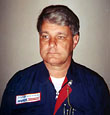|
|
This topic comprises 2 pages: 1 2
|
|
Author
|
Topic: Dealing with broken neon tube
|
|
|
|
|
|
|
|
|
|
|
|
|
|
|
|
|
|
|
|
|
|
|
Bobby Henderson
"Ask me about Trajan."

Posts: 10973
From: Lawton, OK, USA
Registered: Apr 2001
|
 posted 06-20-2004 01:36 PM
posted 06-20-2004 01:36 PM




quote: Steve Kraus
BTW, why can't a neon sign be made with vinyl or other flexible tubing? I presume it can't or someone would have done it.
Aside from bombardment, I don't think it would be possible to heat up plastic, vinyl or any other kind of PVC to the point where it is malliable without the material also becoming pourous or just melting completely apart. You have to be able to bend the glass into lots of different letters and other shapes for creating the artwork. Plastic just wouldn't do for this purpose.
Also, you have the danger that plastic emits lots of toxic gases, etc. when heated. Bending neon glass tube is already a pretty difficult process without getting things like respirators involved. To make neon, you have to enjoy working around more high voltage than it takes to kill prisoners on death row, you have to enjoy burning your fingers on a daily basis and enjoy spending lots of time making glass units (and re-making them when an installer or customer breaks it). Our neon guy curses a blue streak as it is when some unit goes FUBAR on him. I would have to videotape the tirades if he had to work with plastic tube.
Here's another alternative. If what you need are just straight sections, and you have a little more money to spend up front, you could check into some LED-based products. We sometimes use LED strip lighting from a company called Lektron. Their border lighting products can take care of jobs where there isn't enough room for neon components, or if there are too many safety issues with installing genuine neon.
| IP: Logged
|
|
|
|
Bobby Henderson
"Ask me about Trajan."

Posts: 10973
From: Lawton, OK, USA
Registered: Apr 2001
|
 posted 06-20-2004 07:37 PM
posted 06-20-2004 07:37 PM




There's a growing number of companies that make LED lighting for channel letters. The LED company we use for this purpose will take vector artwork we provide and create a drop-in panel with all the LEDs in place. We just attach it to the letter back, hook up the power and it is done. Pretty convenient.
However, IMHO, LED lighting for channel letters still comes up a bit short --particularly when it comes to certain colors. Red is okay for LED lighting. Some of the other LED colors are just not bright enough. All of the blue LED stuff I've seen really sucks ass. Also, the LED method is more expensive on up front building costs than sticking with traditional neon methods. You can gain some cost savings long term through low power consumption.
Just as an aside, I tend to discourage the use of blue in channel letter building sign design for a couple reasons. One, it takes more neon (and a lot more in the way of LEDs) to get a proper level of brilliance in a blue channel letter. Reason two: blue channel letters are much more difficult to read at night when lit. There's something about the wavelength of light that just make them blur out to hell, even when they have a proper level of light. They just have to be BIG. Unfortunately many sign companies will just build the letters with the typical amount of neon or LEDs, just to do what's "good enough." So, consequently, many blue channel letter building signs you see on the commercial landscape (including those of major companies like Honda) just don't read very well.
Finally, LED lighting tends to only work when it is not directly visible. Channel letters with Acrylic faces can use LED lighting as an alternative. But when it comes to exposed lighting LEDs suck ass. Neon is really the only way to go. There is nothing that can fully substitute the look of exposed neon glass --like this example:

Yes, there are fiber optic cable products out there. But check the prices on them as well as the light performance. Fiber optic lighting costs a LOT more and you just don't get as much brilliance as compared to neon. Fiber optic cabling has some nice color chaning capabilities, but as I mentioned you will pay high prices for it.
| IP: Logged
|
|
|
|
|
|
All times are Central (GMT -6:00)
|
This topic comprises 2 pages: 1 2
|
Powered by Infopop Corporation
UBB.classicTM
6.3.1.2
The Film-Tech Forums are designed for various members related to the cinema industry to express their opinions, viewpoints and testimonials on various products, services and events based upon speculation, personal knowledge and factual information through use, therefore all views represented here allow no liability upon the publishers of this web site and the owners of said views assume no liability for any ill will resulting from these postings. The posts made here are for educational as well as entertainment purposes and as such anyone viewing this portion of the website must accept these views as statements of the author of that opinion
and agrees to release the authors from any and all liability.
|

 Home
Home
 Products
Products
 Store
Store
 Forum
Forum
 Warehouse
Warehouse
 Contact Us
Contact Us




 Printer-friendly view of this topic
Printer-friendly view of this topic








![[thumbsup]](graemlins/thumbsup.gif)



![[Smile]](smile.gif)






